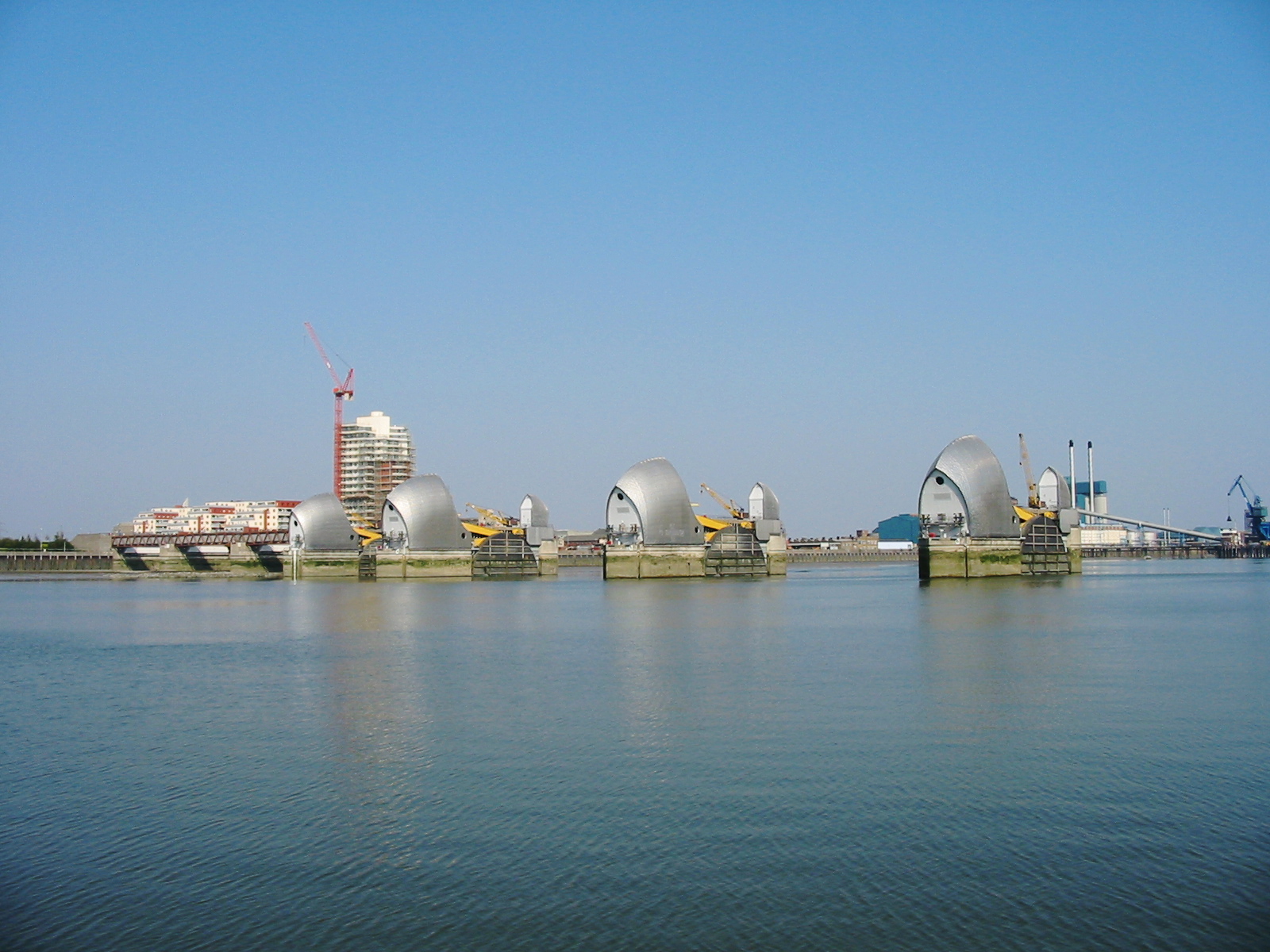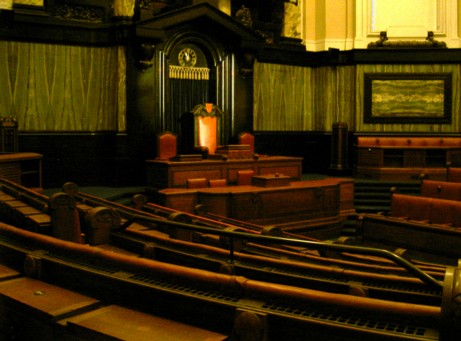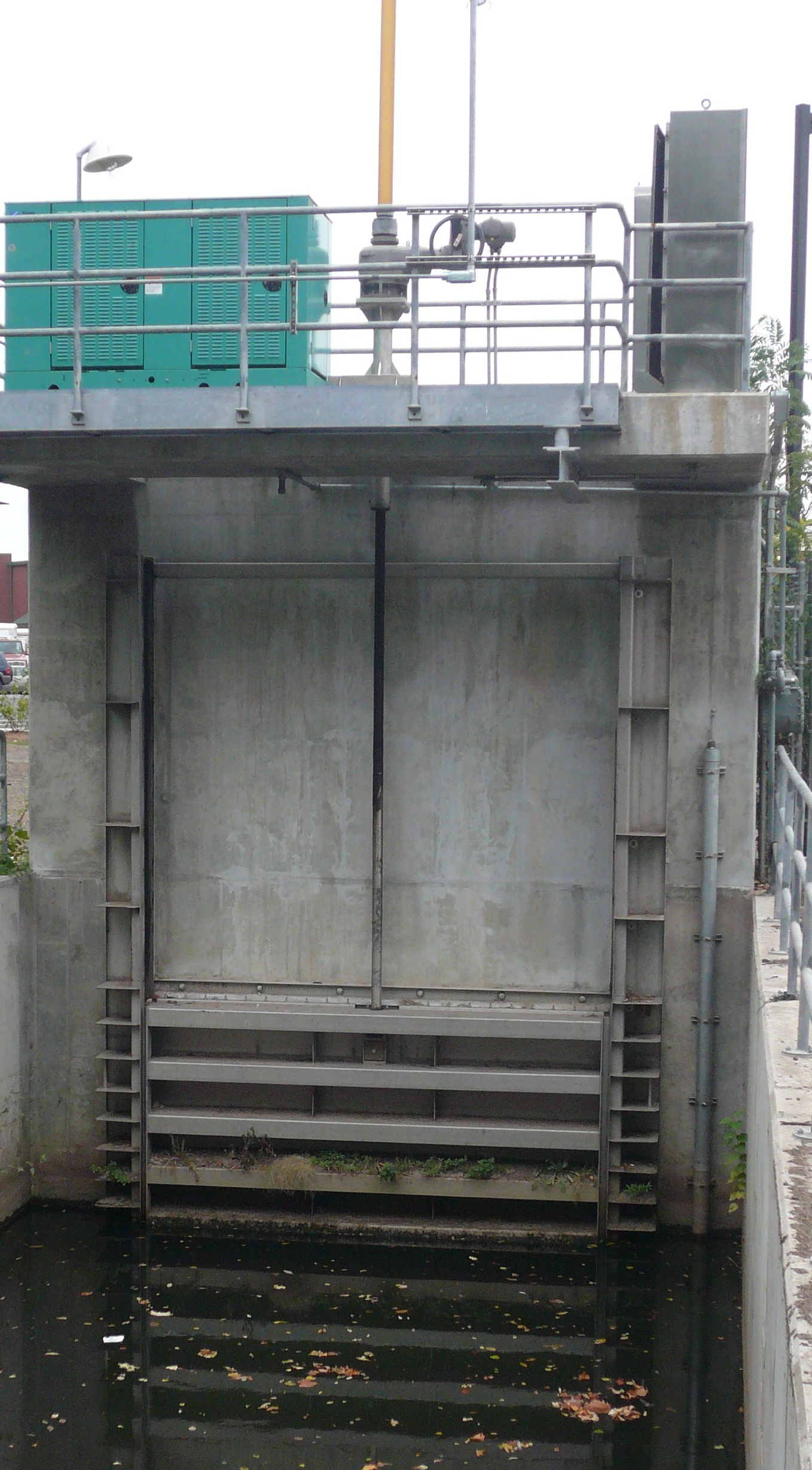|
Thames Barrier
The Thames Barrier is a retractable barrier system built to protect the floodplain of most of Greater London from exceptionally high tides and storm surges moving up from the North Sea. It has been operational since 1982. When needed, it is closed (raised) during high tide; at low tide, it can be opened to restore the river's flow towards the sea. Built about east of the Isle of Dogs, its northern bank is in Silvertown in the London Borough of Newham and its southern bank is in the New Charlton area of the Royal Borough of Greenwich. History Background Flooding in London has been a problem since Roman times. In 1954, the Waverley Committee, established to investigate the serious North Sea flood of 1953 which affected parts of the Thames Estuary and parts of London, recommended that "as an alternative to raising the banks, the possibility and cost of erecting a structure across the Thames which could be closed in a surge should be urgently investigated". A number of designs ... [...More Info...] [...Related Items...] OR: [Wikipedia] [Google] [Baidu] |
London
London is the Capital city, capital and List of urban areas in the United Kingdom, largest city of both England and the United Kingdom, with a population of in . London metropolitan area, Its wider metropolitan area is the largest in Western Europe, with a population of 14.9 million. London stands on the River Thames in southeast England, at the head of a tidal estuary down to the North Sea, and has been a major settlement for nearly 2,000 years. Its ancient core and financial centre, the City of London, was founded by the Roman Empire, Romans as Londinium and has retained its medieval boundaries. The City of Westminster, to the west of the City of London, has been the centuries-long host of Government of the United Kingdom, the national government and Parliament of the United Kingdom, parliament. London grew rapidly 19th-century London, in the 19th century, becoming the world's List of largest cities throughout history, largest city at the time. Since the 19th cen ... [...More Info...] [...Related Items...] OR: [Wikipedia] [Google] [Baidu] |
Silvertown
Silvertown is a district of West Ham in the London Borough of Newham, in east London, England. It lies on the north bank of the River Thames, Thames and was historically part of the parishes of West Ham and East Ham, Becontree Hundred, hundred of Becontree, and the Historic counties of England, historic county of Essex. London Government Act 1963, Since 1965, Silvertown has been part of the London Borough of Newham, a Districts of England, local government district of Greater London. It forms part of the E postcode area, London E16 postcode district along with Canning Town and Custom House, Newham, Custom House. The area was named after the factories established by Stephen William Silver in 1852,. The riverside of central Silvertown continues to be dominated by the Tate & Lyle sugar refinery, with residential developments being built to its east and west. Central Silvertown features St Marks Church (now Brick Lane Music Hall), London City Airport, and a new community arts ... [...More Info...] [...Related Items...] OR: [Wikipedia] [Google] [Baidu] |
Greater London Council
The Greater London Council (GLC) was the top-tier local government administrative body for Greater London from 1965 to 1986. It replaced the earlier London County Council (LCC) which had covered a much smaller area. The GLC was dissolved in 1986 by the Local Government Act 1985 and its powers were devolved to the London boroughs and other entities. A new administrative body, known as the Greater London Authority (GLA), was established in 2000. Background In 1957 a Royal Commission on Local Government in Greater London had been set up under Edwin Herbert, Baron Tangley, Sir Edwin Herbert to consider the local government arrangements in the London area. It reported in 1960, recommending the creation of 52 new London boroughs as the basis for local government. It further recommended that the LCC be replaced by a weaker strategic authority, with responsibility for public transport, road schemes, housing development and regeneration. The Greater London Group, a research centre of ac ... [...More Info...] [...Related Items...] OR: [Wikipedia] [Google] [Baidu] |
Compressed Air
Compressed air is air kept under a pressure that is greater than atmospheric pressure. Compressed air in vehicle tires and shock absorbers are commonly used for improved traction and reduced vibration. Compressed air is an important medium for the transfer of energy in industrial processes and is used for power tools such as air hammer (fabrication), air hammers, Jackhammer, drills, power wrench, wrenches, and others, as well as to atomize paint, to operate air cylinders for automation, and can also be used to propel vehicles. Brakes applied by compressed air made large railway trains safer and more efficient to operate. Compressed air brakes are also found on large highway vehicles. Compressed air is used as a breathing gas by underwater diving, underwater divers. The diver may carry it in a high-pressure diving cylinder, or surface supplied diving, supplied from the surface at lower pressure through an air line or diver's umbilical. Similar arrangements are used in breathing ap ... [...More Info...] [...Related Items...] OR: [Wikipedia] [Google] [Baidu] |
River Bed
A streambed or stream bed is the bottom of a stream or river and is confined within a channel or the banks of the waterway. Usually, the bed does not contain terrestrial (land) vegetation and instead supports different types of aquatic vegetation (aquatic plant), depending on the type of streambed material and water velocity. Streambeds are what would be left once a stream is no longer in existence. The beds are usually well preserved even if they get buried because the banks and canyons made by the stream are typically hard, although soft sand and debris often fill the bed. Dry, buried streambeds can actually be underground water pockets. During times of rain, sandy streambeds can soak up and retain water, even during dry seasons, keeping the water table close enough to the surface to be obtainable by local people. The nature of any streambed is always a function of the flow dynamics and the local geologic materials. The climate of an area will determine the amount of precip ... [...More Info...] [...Related Items...] OR: [Wikipedia] [Google] [Baidu] |
Crayford
Crayford is a town and Wards of the United Kingdom, electoral ward in South London, South East London, England, within the London Borough of Bexley. It lies east of Bexleyheath and north west of Dartford. Crayford was in the Historic counties of England, historic county of Kent until 1965. The settlement developed by the river Cray, around a ford that is no longer used. History An Iron Age Britain, Iron Age settlement existed in the vicinity of the present Church of St Paulinus, St Paulinus Church between the Caesar's invasion of Britain, Julian and Roman conquest of Britain, Claudian invasions of Britain, from roughly 30 BC to AD 40. Roman ruins have been discovered and Crayford is one of several places proposed as the site of Noviomagus Cantiacorum, a place mentioned in the Antonine Itinerary as being on the Roman equivalent of the later Watling Street. Crayford is also plausible as the site of the bloody battle of Crecganford ("Creeksriver ford, ford") in 45 ... [...More Info...] [...Related Items...] OR: [Wikipedia] [Google] [Baidu] |
Sluice Gate
A sluice ( ) is a water channel containing a sluice gate, a type of lock to manage the water flow and water level. There are various types of sluice gates, including flap sluice gates and fan gates. Different depths are calculated when design sluice gates. Sluices are used for channeling water toward a water mill, including for transporting logs from steep hillsides. Different terms are used regionally for sluices; the terms ''sluice'', ''sluice gate'', ''knife gate'', and ''slide gate'' are used interchangeably in the water and wastewater control industry. Etymology The term "sluice" originates from the Middle English word scluse, which derived from the Old French escluse (modern French: écluse). This, in turn, came from the Late Latin exclusa, a shortening of aqua exclusa, meaning "excluded water" or "a shut-off water channel." The Latin exclusa is the feminine past participle of excludere ("to shut out, exclude"), from *ex-* ("out") and claudere ("to close"). Regional ... [...More Info...] [...Related Items...] OR: [Wikipedia] [Google] [Baidu] |
Home Secretary
The secretary of state for the Home Department, more commonly known as the home secretary, is a senior minister of the Crown in the Government of the United Kingdom and the head of the Home Office. The position is a Great Office of State, making the home secretary one of the most senior and influential ministers in the government. The incumbent is a statutory member of the British Cabinet and National Security Council (United Kingdom), National Security Council. The position, which may be known as interior minister in other nations, was created in 1782, though its responsibilities have Home Office#History, changed many times. Past office holders have included the prime ministers Lord North, Robert Peel, the Duke of Wellington, Lord Palmerston, Winston Churchill, James Callaghan and Theresa May. The longest-serving home secretary is Henry Addington, 1st Viscount Sidmouth, who held the post continuously for 9 years, 221 days. The shortest-serving home secretary is Grant Shapps, w ... [...More Info...] [...Related Items...] OR: [Wikipedia] [Google] [Baidu] |
David Maxwell Fyfe, 1st Earl Of Kilmuir
David Patrick Maxwell Fyfe, 1st Earl of Kilmuir, (29 May 1900 – 27 January 1967), known as Sir David Maxwell Fyfe from 1942 to 1954 and as Viscount Kilmuir from 1954 to 1962, was a British Conservative politician, lawyer and judge who combined a legal career with political ambitions that took him to the offices of Solicitor General, Attorney General, Home Secretary and Lord High Chancellor of Great Britain. One of the prosecuting counsels at the Nuremberg Trials, he subsequently played a role in drafting the European Convention on Human Rights. As Home Secretary from 1951 to 1954 he greatly increased the number of prosecutions of homosexuals and declined to commute Derek Bentley's death sentence for the murder of a police officer. His political ambitions were ultimately dashed in Harold Macmillan's cabinet reshuffle of July 1962. Early life Born in Edinburgh, the only son of William Thomson Fyfe, headmaster of Aberdeen Grammar School, by his second wife Isabella Campbe ... [...More Info...] [...Related Items...] OR: [Wikipedia] [Google] [Baidu] |
Thames Estuary
The Thames Estuary is where the River Thames meets the waters of the North Sea, in the south-east of Great Britain. Limits An estuary can be defined according to different criteria (e.g. tidal, geographical, navigational or in terms of salinity). For this reason the limits of the Thames Estuary have been defined differently at different times and for different purposes. Western This limit of the estuary has been defined in two main ways: * The narrow estuary is strongly tidal and is known as the Tideway. It starts in south-west London at Teddington Lock and weir, Teddington/Ham, London, Ham. This point is also mid-way between Richmond Lock which only keeps back a few miles of human-made head (hydrology), head (stasis) of water during low tide and the extreme modern-era head at Thames Ditton Island on Kingston upon Thames, Kingston reach where slack water occurs at maximal high tide in times of rainfall-caused flooded banks. In terms of salinity the transition from freshwater t ... [...More Info...] [...Related Items...] OR: [Wikipedia] [Google] [Baidu] |
North Sea Flood Of 1953
The 1953 North Sea flood () was a major flood caused by a heavy storm surge that struck the Netherlands, north-west Belgium, England and Scotland. Most sea defences facing the surge were overwhelmed, resulting in extensive flooding. The storm and flooding occurred during the night of Saturday, 31 January to the morning of 1 February 1953. A combination of a high spring tide and a severe European windstorm caused a storm tide of the North Sea. The combination of wind, high tide, and low pressure caused the sea to flood land up to above mean sea level. Realising that such infrequent events could reoccur, the Netherlands and the United Kingdom carried out large studies on strengthening of coastal defences. The Netherlands developed the Delta Works, an extensive system of dams and storm surge barriers. The UK constructed storm surge barriers on the Thames Estuary and on the Hull where it meets the Humber Estuary. Flooding summary At the time of the flood, 20% of the lan ... [...More Info...] [...Related Items...] OR: [Wikipedia] [Google] [Baidu] |
Roman Britain
Roman Britain was the territory that became the Roman province of ''Britannia'' after the Roman conquest of Britain, consisting of a large part of the island of Great Britain. The occupation lasted from AD 43 to AD 410. Julius Caesar invaded Britain in 55 and 54 BC as part of his Gallic Wars. According to Caesar, the Britons had been overrun or culturally assimilated by the Belgae during the British Iron Age and had been aiding Caesar's enemies. The Belgae were the only Celtic tribe to cross the sea into Britain, for to all other Celtic tribes this land was unknown. He received tribute, installed the friendly king Mandubracius over the Trinovantes, and returned to Gaul. Planned invasions under Augustus were called off in 34, 27, and 25 BC. In 40 AD, Caligula assembled 200,000 men at the Channel on the continent, only to have them gather seashells () according to Suetonius, perhaps as a symbolic gesture to proclaim Caligula's victory over th ... [...More Info...] [...Related Items...] OR: [Wikipedia] [Google] [Baidu] |










